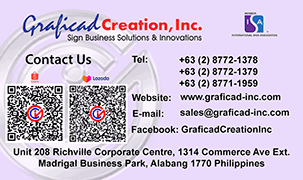
 |
|---|
|
|
|---|
 |
Graficad Creation, Inc. Unit 208 Richville Corporate Centre, 1314 Commerce Avenue Extension Madrigal business Park, Alabang, Muntinlupa City, Philippines 1770 Telephone: +63 (2) 772-1378; 772-1379; 771-1959; 973-7042 Facsimile: +63 (2) 772-1380 Webasite: www.graficad-inc.com E-mail: sales@graficad-inc.com |
 |
|---|
Graficad Creation, Inc. 2013 , All Rights Reserved |
|---|